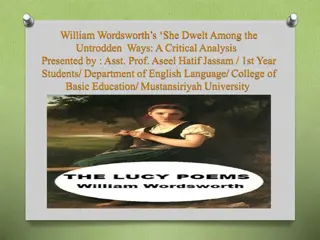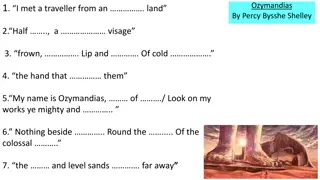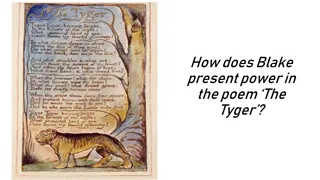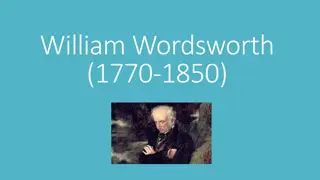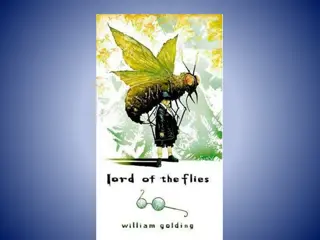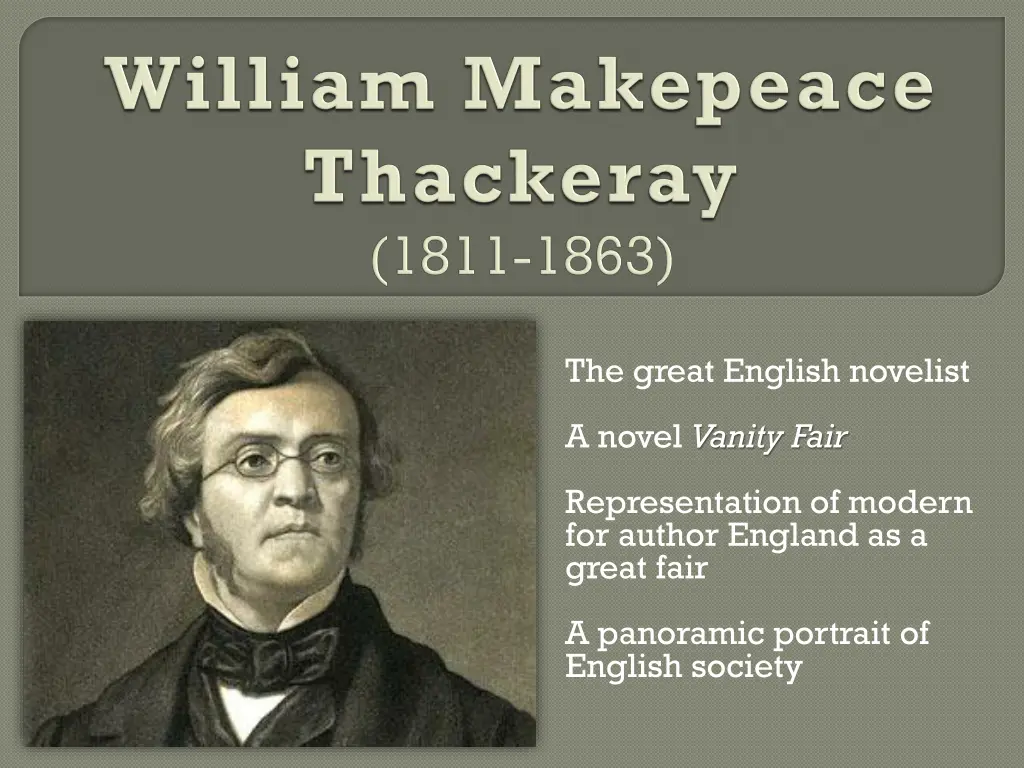
William Thackeray: Novelist of Vanity Fair and Social Commentary
William Makepeace Thackeray, a renowned English novelist, is best known for his novel "Vanity Fair," offering a panoramic view of English society. Born in Calcutta in 1811, Thackeray faced personal struggles with gambling and financial pressure. His work reflects penetrating observations of human nature, critiquing social climbers, snobs, and egotists. Through his satirical portrayal of characters, Thackeray illuminates the flaws and vanities of a materialistic society.
Download Presentation

Please find below an Image/Link to download the presentation.
The content on the website is provided AS IS for your information and personal use only. It may not be sold, licensed, or shared on other websites without obtaining consent from the author. If you encounter any issues during the download, it is possible that the publisher has removed the file from their server.
You are allowed to download the files provided on this website for personal or commercial use, subject to the condition that they are used lawfully. All files are the property of their respective owners.
The content on the website is provided AS IS for your information and personal use only. It may not be sold, licensed, or shared on other websites without obtaining consent from the author.
E N D
Presentation Transcript
The great English novelist A novel Vanity Fair Representation of modern for author England as a great fair A panoramic portrait of English society
William Makepeace Thackeray was born in Calcutta in 1811. He was educated at Charterhouse and Trinity College, Cambridge. However, Thackeray became addicted to gambling and left Cambridge in 1830 without a degree and heavily in debt. At first Thackeray tried to make a living as a painter but after this ended in failure he turned to journalism. Thackeray moved to Paris where he became the French correspondent for the radical newspaper, The Constitutional. When The Constitutional ceased publication, Thackeray moved back to England and began contributing articles to a wide variety of newspapers and journals, including The Times, The Morning Chronicle, Fraser's Magazine and Punch Magazine. Thackeray also began writing novels. Thackeray published his most famous novel, Vanity Fair. This was followed by The History of Henry Esmond, The Newcomes and The Virginians. Although a successful novelist, he continued to write articles for journals such as Punch Magazine. Thackeray died in 1863.
In 1836 he met Isabella Shawe, a timid, simple and artless girl. He fell outrightly in love with Isabella and they married. Thackeray and Isabella Shawe had a happy life during their first years of marriage. But as financial demands forced Thackeray into more and more work, Isabella became isolated and lonely. The happy years of marriage was eclipsed by the tragic death of their second daughter Jane.
The Yellowplush Papers (1837) Catherine (1839) A Shabby Genteel Story (1840) The Irish Sketchbook (1843) The Luck of Barry Lyndon (1844) Mrs. Perkins's Ball (1846) The Book of Snobs (1848) Vanity Fair (1848) Rebecca and Rowena (1850) The Paris Sketchbook (1840) Men's Wives (1852) The Rose and the Ring (1855) The Virginians (1859) Four Georges (1861) The Adventures of Philip (1862)
An evil person is like a dirty window, they never let the light shine through. William Thackeray Vanity Fair, based on the writer's penetrating observation of human nature, exposes all aspects of it: people are weak and vain, self- absorbed, self-deceived. Three kinds of people are shown and criticized here: social climbers, snobs and egotists. By tracing the interweaving destinies of two contrasted heroines during the period of Waterloo and its aftermath, the novel is a vast satirical panorama of a materialistic society. Satire is the most distinguishing feature of the novel. The reader can find satire everywhere from the title to descriptions and portrayal of characters, from the author's comments to the narrations of the characters' life.
The story is set at the time of the Napoleonic wars, and gives a satirical picture of a worldly society, which Thackeray intended to be applied also to his own times. It follows the fortunes of two sharply contrasted characters - Becky Sharp and Amelia Sedley. The two girls, as unlike in character as they are in fortune, have been educated at Miss Pinkerton's Academy for young ladies.
Becky becomes governess to the children of Sir Pitt Crawley. She is already married, to his younger son Rawdon. Amelia's engagement to George Osborne, the handsome but vain and shallow son of another magnate, has been broken off. William Dobbin is secretly in love with Amelia, but he persuades George to go on with the marriage. Amelia and Becky accompany their husbands to Belgium, where Becky carries on an intrigue with George. George is killed at Waterloo, and Amelia, with her baby, goes to live in poverty with her parents. Dobbin was despairing of ever winning Amelia's love. Becky leads a disreputable life. Amelia steadfastly refuses to marry Dobbin until meeting Becky, who tells her of George s infidelity. Disillusioned, she marries Dobbin, but by then his love for her has lost much of its intensity.






